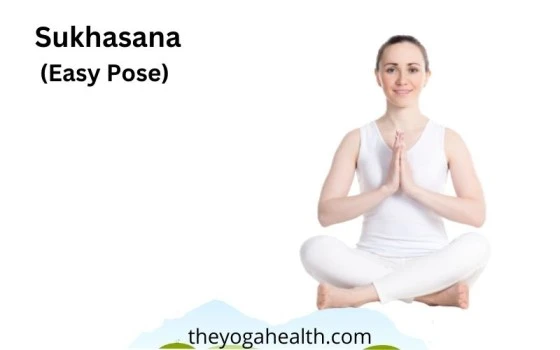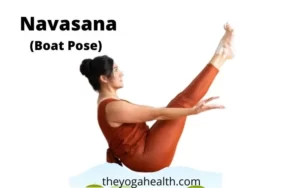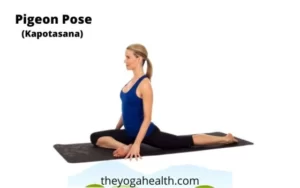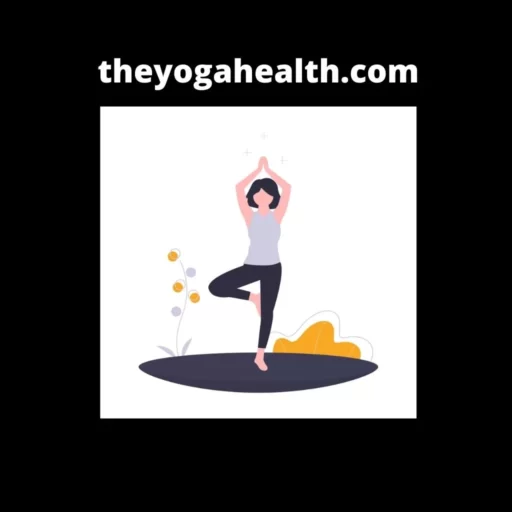In the modern world being peaceful is becoming difficult. But there is one easy yet powerful yoga technique that can help you achieve relaxation, flexibility and mental peace. That Yoga technique is Sukhasana, which is also known as ‘Easy Pose’ in English language.
Modern times are full of constant distractions and finding moments of inner peace and contentment is essential for our overall health. This asana, offers a simple and effective way to achieve this.
Table of Contents
Sukhasana (Easy Pose)
The term “Sukhasana” is derived from two Sanskrit words – “Sukha” which translates to “ease” or “happiness,” and “Asana” which means “pose.”
This is very easy pose yet it is perfectly normal that you may encounter some challenges in the beginning. So be patient with yourself and allow the practice to evolve naturally.
Basic Details:
| Sanskrit Name | Sukhasana |
| English Name | Easy Pose |
| Difficult Level | Beginner |
| Position | Sitting |
How To Do Sukhasana:
Step 1: To get into this asana, find yourself a comfortable and quiet place to sit. You can use floor or a yoga mat as per your convenience.
Step 2: Now, cross your legs and place each foot beneath the opposite knee. Place your hands on your knees and your palms should be facing upward.
Step 3: During the pose make sure that your spine is straight and your shoulders are relaxed. Your chin should be parallel to the ground.
Step 4: Now close your eyes, take a deep breath, and let all tensions of life go out of your body.
Sukhasana Benefits:
1. Relieves Stress and Anxiety:
When you sit in this asana it encourage relaxation and allows deep breathing. It is helpful in reducing stress and anxiety levels. In this pose you will feel disconnected from the outside world and find a few moments of inner peace.
2. Improves Flexibility:
This pose has the ability to stretch the hips, knees and ankles. As you continue with the asana over time your flexibility will improve. This is an excellent pose for people with tight hips.
3. Enhances Focus and Concentration:
Sukhasna helps to improve focus and concentration. It calms the mind and reduces distraction. This pose is particularly beneficial for students and people who do more mentally demanding jobs.
4. Aids Digestion:
The gentle compression of the abdomen during this asana can aid digestion and help alleviate gastrointestinal discomfort.
You May Also Like: Padmasana (Lotus Pose)
Real-life Experiences:
Let’s take a look at how easy pose has positively impacted the lives of real people:
1. Rachel’s Story: Rachel is a working professional and she was having issues with insomnia and work-related stress. After she started doing easy pose, she noticed a significant improvement in her sleep quality and a reduction in her stress levels.
2. Mark’s Journey: Mark who was always an athlete, as he grew old, he started feeling stiffness in his hips and lower back. On the advice of his neighbor, he started attending yoga classes, where he was made to sit in easy pose for some time. After a few days he found his flexibility has improved and relief from his discomfort.
Precautions:
While easy pose is generally safe and accessible to most people, there are a few precautions to keep in mind:
1. Knee Discomfort:
If you experience knee pain or discomfort while practicing this asana, try sitting on a cushion or folded blanket to elevate your hips slightly. This modification can reduce pressure on the knees.
2. Pregnancy:
Pregnant women should practice this asana with caution, especially during the later stages of pregnancy. It is advisable to consult with a prenatal yoga instructor or healthcare provider for suitable modifications.
3. Back Issues:
If you have chronic back issues or injuries, it’s essential to be gentle while practicing this asana. Consider using additional props like a bolster or sitting against a wall for added support. You can take the help of the wall for your back support, it will provide relief if you are suffering back pains.
4. Breathing Techniques:
Breathing plays a crucial role in this asana. When you sit in this asana, focus on your breath. Take deep and slow breath, inhale through your nose and exhale through your mouth.
5. Avoid Noisy areas with too much sound or music:
While doing this pose avoid sitting in areas where there is too much noise or loud music playing. Concentration and focus of your mind will be difficult in such noisy areas.
Duration and Consistency:
Although easy pose can be practiced at any time of the day but it will be more beneficial during early morning and evening time. In the morning we start our day and in the evening we close our day so it make sense to start and close our day in a relaxed mode.
In the beginning you can start sitting for just a few minutes and gradually you can increase the duration as your become more comfortable with the pose. Try you incorporate this asana into your daily life for maximum results.
Combining easy pose with Meditation:
For an enhanced experience, consider pairing this asana with meditation. After finding a comfortable seat, bring your focus to your breath or a specific point of concentration. The combination of this asana and meditation can deepen your sense of relaxation and self-awareness.
Sukhasana Variations:
While Sukhasana is a straightforward pose, there are a few variations that can add depth to your practice:
1. Half Sukhasana:
If you find crossing your legs challenging in this asana, in that case you can try Half Sukhasana pose.
For that you have to sit with one leg crossed in front of the other leg and place the opposite foot under the knee of the front leg. This modification still provides many of the benefits of the full pose while being gentler on the knees and hips.
2. Sukhasana Side Bend:
This Variation of the asana can be performed by bending towards the side for one minute and then repeating the same on the other side of the body. It will help stretch muscles of the neck, chest, shoulders, and side abdomen.
This Variation of the asana is very easy to perform. In this pose the practitioner simply has to bend forward. It will lengthen the spine and lower back muscles. It will also help in removing any stiffness in the lower back muscles.
3. Sukhasana Forward Bend:
This Variation of the asana is very to perform. In this pose the practitioner has to bend forward. It will lengthen the spine and lower back muscles. It will also help in removing any stiffness in the lower back muscles.
4. Supported Sukhasana:
For those who struggle with maintaining an upright posture, using props like a cushion, yoga block, or bolster can offer support and make the pose more accessible. Elevating your hips with props can also help alleviate any discomfort in the knees or lower back.
5. Dynamic Sukhasana:
As you feel yourself easy and comfortable with the basic Pose, you can start adding few gentle movements to the pose. In the sitting position, inhale as you lengthen your spine and during exhale gently twist your torso to one side.
Inhale back to the center and repeat on the other side.These simple movements can release tension from the spine and enhance flexibility.
You May Also Like: Child Pose (Balasana)
Incorporating into Daily Life:
Easy pose is an independent yoga pose yet it can be incorporated into various aspects of our daily life for more benefits.
1. Desk Breaks:
If you have deskbound job and you have to sit on a desk for prolonged periods then you can take a short breaks every one hour. To rejuvenate your mind and body you can sit in easy pose pose during these short breaks.
2. Mindful Meals:
During mealtime, consider sitting in easy pose before eating. This practice can help you become more present and mindful of the food you’re consuming, enhancing the overall dining experience. In rural India people prefer to eat their meals sitting in easy pose only, which is a good practice for their over all health.
3. Before Bed:
Engage in easy pose before bedtime as part of a winding-down routine. This will signal your body and mind that it’s time to relax, promoting better sleep.
The Power of Simplicity:
The most beautiful aspect of easy pose is its simplicity. This asana does not require any fancy equipment or specific requirements. It is accessible to people of all ages and fitness levels. You are experienced or new to the world of Yoga, easy pose is for everybody.
As you regularly practice easy pose you will start noticing positive changes in your physical and mental health.
You will find most of the sages from India are always sitting in this asana for meditation and other purposes. You will also notice, traditionaly in India people always prefer to eat their meals sitting in this asana. With regular practice, you can also experience the physical and mental benefits of this ancient Yoga pose.
Exploring the Philosophy:
Beyond its physical benefits, easy pose also embodies profound philosophical principles that can enrich our lives:
1. Sukha – The Essence of Happiness:
Sukhasana encourages us to seek happiness and contentment in simplicity. It reminds us that true joy lies not in material possessions but in finding comfort within ourselves.
2. Grounding and Connection:
easy pose’s seated position symbolizes grounding and connection with the Earth. Many times in our life we become disconnected from our surroundings and ourselves. This pose encourages us to be in the present moment and we feel more centered and balanced.
3. Cultivating Stillness:
In today’s digitally-driven world, our minds are bombarded with constant stimuli. easy pose invites us to embrace stillness and silence, giving our minds a chance to rest and rejuvenate. In this stillness, we can tap into our inner wisdom and find answers to life’s questions.
4. Letting Go:
As we settle into easy pose, we may notice tensions and thoughts arising. The practice encourages us to acknowledge these feelings and then let them go, like passing clouds. Learning to release attachments and worries can lead to a sense of emotional liberation.
5. Expanding the Practice:
easy pose can be a gateway to further exploration of yoga and mindfulness practices. Here are some ways to expand your journey:
6. Breathing (Pranayama):
Combine easy pose with pranayama, the practice of breath control. Simple breathing exercises like “Nadi Shodhana” (alternate nostril breathing) or “Deep Belly Breathing” can deepen relaxation and balance the mind.
7. Mindfulness Meditation:
After settling into easy pose, engage in mindfulness meditation. Observe your thoughts without judgment and bring your attention back to your breath whenever the mind wanders. This practice can enhance self-awareness and reduce mental chatter.
8. Gratitude Practice:
Before or after this asana, take a moment to reflect on things you’re grateful for. Cultivating gratitude can shift your focus from what’s lacking to appreciating the abundance in your life.
9. Yoga Nidra:
Often referred to as “yogic sleep,” Yoga Nidra is a guided meditation that induces deep relaxation and promotes healing on various levels. Practice it in this asana to experience profound rejuvenation.
Taking Easy Pose Beyond the Mat:
Easy pose is not limited to the yoga mat; its essence can be integrated into our daily interactions and experiences:
Acts of Kindness:
Embody the principles of this asana by spreading kindness and compassion to others. A simple smile or a thoughtful gesture can brighten someone’s day and create a ripple effect of positivity.
Gracious Listening:
Be fully present when listening to others, offering them your undivided attention. This act of mindful listening can deepen connections and strengthen relationships.
Nature Connection:
Spend time in nature and practice this asana outdoors, connecting with the natural world. The sights, sounds, and scents of nature can be incredibly calming and restorative.
Digital Detox:
Take regular breaks from screens and gadgets to reduce digital overwhelm. Use easy pose as a moment to unplug and be fully present in the here and now.
You May Also Like: Happy Baby Pose (Ananda Balasana)
Conclusion:
Sukhasana (Easy Pose) offers us much more than just a physical posture. This pose is a gateway to happiness, stillness and self-awareness. It only takes a few moments in this asana to experience the profound bliss that resides within each one of us.
This pose is a gateway to a realm of peace and tranquility. By incorporating this asana into your life, you will not only reap physical benefits of increased flexibility and better posture but also rewards of reduced stress and enhanced focus. In that simple act of stillness and self-awareness, you may discover the extraordinary power of finding serenity in the ordinary.
Take a few moments every day to sit in this pose and you will discover a new sense of calm and peacefulness. Embrace this blissful seat, and let its positive influence flow into every aspect of your life, nurturing your mind, body, and soul.
FAQs: Sukhasana
Q1. What is Sukhasana, and how do I practice it?
Sukhasana is a basic yoga posture. It is performed by sitting cross-legged on the floor with hands resting on the knees. The step by step instructions to perform this asana is given above in the article.
Q2. What are the benefits of easy pose?
This asana offers many benefits; it helps in better digestion, more focus, flexible body, stress reduction etc. It is a good starting pose for the beginners and can also a starting point for more advanced yoga poses.
Q3. Can anyone do easy pose?
This asana is suitable for people of all ages and fitness levels. It is a gentle pose that can be practiced by beginners and as well as by the experienced practitioners.
Q4. How long should I hold easy pose during my practice?
The duration of this asana can vary based on your comfort level and experience. In the beginning one can sit in the pose for 1 to 5 minutes. As one gets more comfortable with the pose he can extend his time to 10 or even 15 minutes.
Q5. Can easy pose help with stress and anxiety?
Yes, it can be an effective tool for reducing stress and anxiety. The relaxed seated position and focused breathing help calm the nervous system and promote a sense of inner peace.
Q6. Is it necessary to meditate while in easy pose, or can I simply sit quietly?
While meditation can be combined with this asana for a deeper experience, it is not mandatory. You can also use this pose to sit quietly and practice deep breathing without formal meditation.
Q7. Can pregnant women practice easy pose?
Pregnant women can practice this pose during the early stages of pregnancy. However, as the pregnancy progresses, it’s advisable to modify the pose or switch to more suitable prenatal yoga poses.
Q8. How often should I practice easy pose?
It can be practiced daily or as often as you like. Even a short session each day can bring positive benefits to your body and mind.
Q9. Are there any precautions to keep in mind while practicing easy pose?
If you have knee issues, discomfort, or lower back problems, you may need additional support during this asana. Using props like cushions or sitting against a wall can alleviate discomfort.
Q10. Can easy pose be practiced by children and seniors?
Yes, this pose is suitable for people of all age groups, including children and seniors. It is an excellent pose for promoting relaxation and maintaining flexibility, making it accessible to individuals of varying abilities.
Share your experience of doing this asana and if you have questions or comments, you can mention so in the comments section below.







